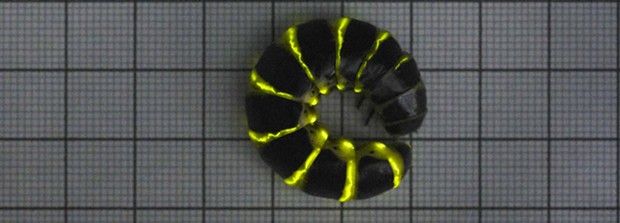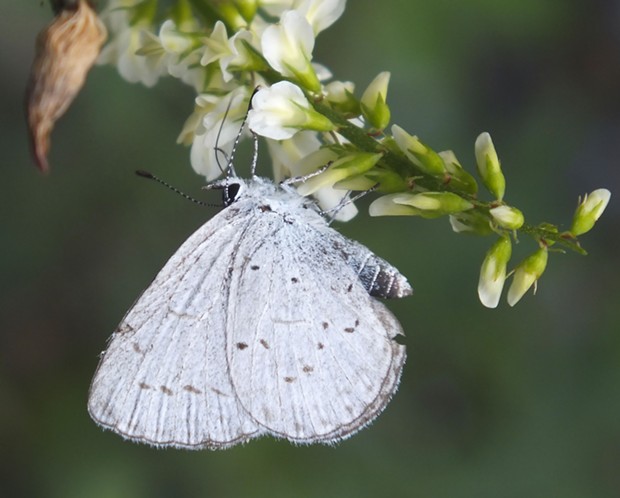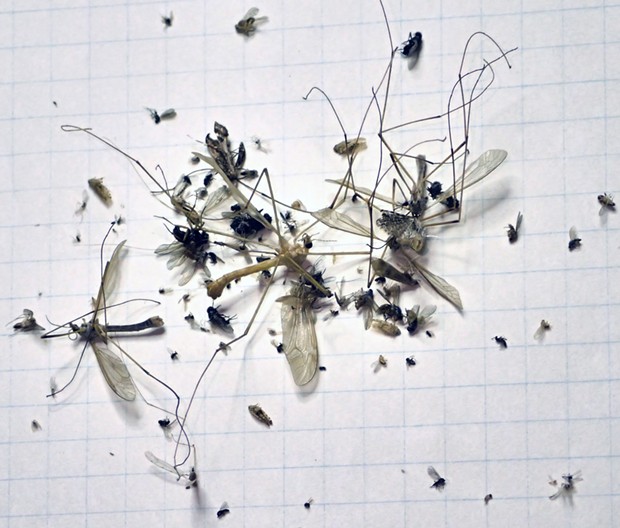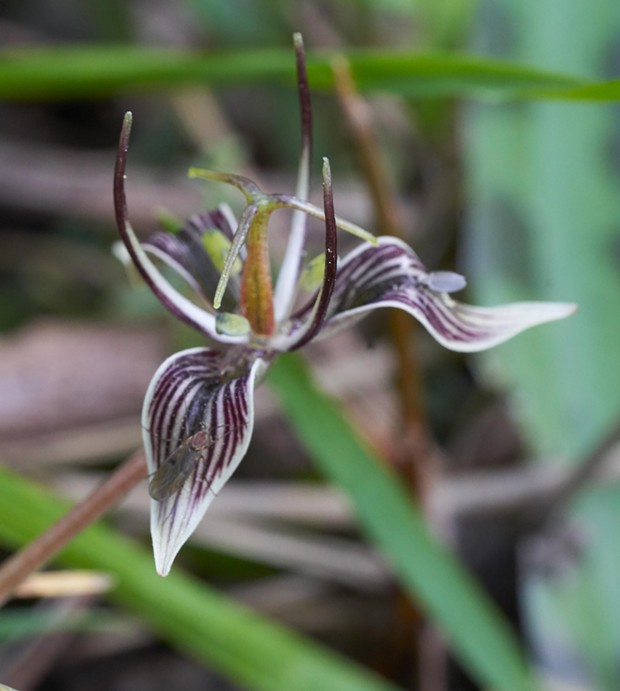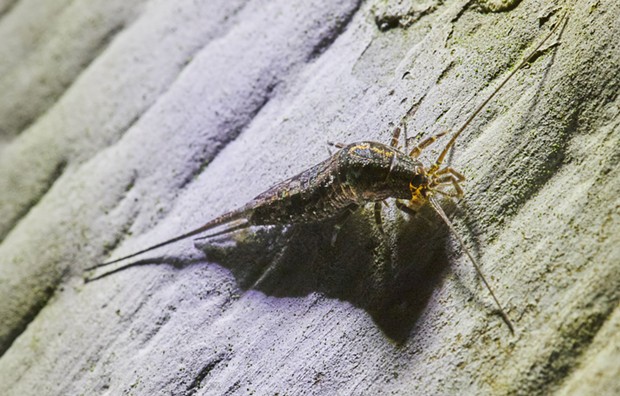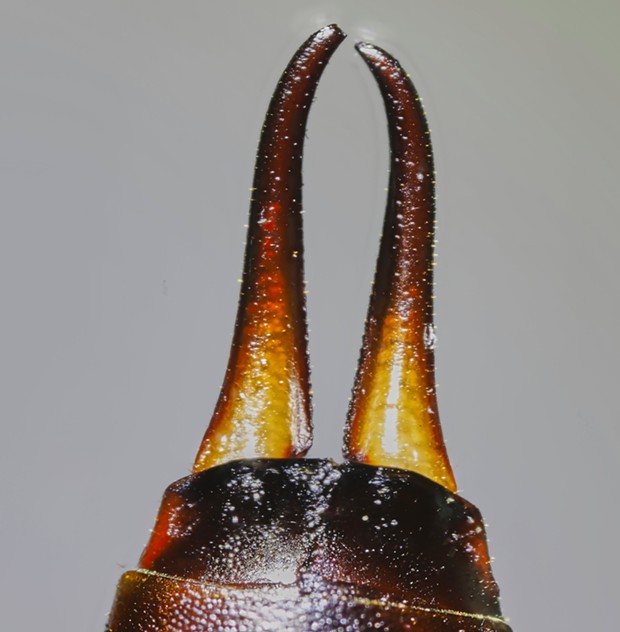Science
Sunday, April 28, 2019
HumBug: Spring Bug Break
Posted By Anthony Westkamper on Sun, Apr 28, 2019 at 11:16 AM
Spring is finally, really, underway. I took a walk along the Van Duzen River got nearly 100 photos of invertebrate wildlife. There were three different kinds of dragonfly: California darners, variegated meadowhawks and a single female red rock skimmer.
Sunday, April 21, 2019
HumBug: New Neighbors
Posted By Anthony Westkamper on Sun, Apr 21, 2019 at 1:00 PM
Late the other evening, my wife and I went out for a walk. Along the road we saw several large shiny brown millipedes. In the middle of the road, apparently investigating a smeared member of that species, was something that at first looked like a slightly smaller one. On closer inspection, it was something completely different. I didn't have a camera or a jar, so my very tolerant wife volunteered to stay and keep track the bug in question while I got something to collect it with. For the first time in years I actually ran (it was a short distance) and retrieved an empty spice shaker bottle. They're my favorite collecting vessel; made of tough of plastic they come in a convenient variety of sizes, are break-proof, clear and come with lids already perforated with air holes.
Sunday, April 14, 2019
HumBug: Bugs Between the Raindrops
Posted By Anthony Westkamper on Sun, Apr 14, 2019 at 1:30 PM
Despite the dreary weather, life must go on. Eager to get along with their lives, our local insects show up even for the brief patches of sunshine that occasionally grace my back yard. Mostly disdained by the local honeybees, oxalis, dandelions and English daisies draw a crowd.
Sunday, March 31, 2019
HumBug: Partial Sun, Chance of Butterflies and Bees
Posted By Anthony Westkamper on Sun, Mar 31, 2019 at 11:09 AM
Well, at least we had one sunny day. Along with the rest of us, the insects crawled from their hidey holes in bark crevasses, burrows in the ground and old wood.
A couple of days ago I got a brief glimpse of what I suspected was a California tortoiseshell butterfly (Nymphalis californica). Sometimes, for reasons that aren't clear, their population can explode. Some years ago I counted nearly 100 of them apparently migrating upstream along the Van Duzen River. On Thursday a dozen or so flitted about the plum trees in my yard. They were accompanied by nearly as many painted lady butterflies (Vanessa cardui), purported to be the most widespread butterfly in the world seen on all continents except Antarctica.
Sunday, March 24, 2019
HumBug: Spring May Have Finally Sprung
Posted By Anthony Westkamper on Sun, Mar 24, 2019 at 9:00 AM
After a few false starts it feels like spring is finally underway. Days ago, a walk in the woods with my dogs produced a tick. I've said before I do not like ticks but as a community service I try to give a heads up when I see them about.
I also kicked up what I believe was an Echo Azure (Celastrina echo) butterfly. These tiny shiny blue butterflies flit along the damp places of the river bar. Unfortunately, when they land, they usually hold their wings over their back exposing the gray undersides and hiding the bright blue uppers. Only occasionally opening them when perched and displaying to attract a mate.
Sunday, March 10, 2019
HumBug: Going into the Light (Fixture)
Posted By Anthony Westkamper on Sun, Mar 10, 2019 at 2:00 PM
In an effort to make one of those yucky housecleaning tasks a tad more interesting, I decided to check out the dead bugs in my kitchen light fixture before feeding them to my goldfish. In the past I've found millipedes and, once upon a time, even a potato bug (Jerusalem cricket). How that got up there is anybody's guess.
It is well known that many insects are phototrophic (attracted to lights) but in the case of the Jerusalem cricket, it is just the opposite. They live under rocks and logs and ordinarily shun the light.
Electric lights can be deadly to insects, especially semi-enclosed ones that get warm. Small as they are, insects are continually fighting a battle to maintain the proper water content in their bodies. That is why insecticidal soaps work. They dissolve a thin layer of waxy material that helps slow the animal's water gain or loss.
Monday, March 4, 2019
HumBug: Blooming too Early or Bugs too Late?
Posted By Anthony Westkamper on Mon, Mar 4, 2019 at 9:24 AM
Despite the weather lately, spring is happening, at least in the plant world. Last night on a walk, I saw fetid adder's tongue (aka “brownies,” aka Scoliopus bigelovi), and Indian plum (Oemleria cerasiformis) and a patch of naturalized daffodils, all in bloom. Along with brilliant yellow acacia and the pink and white fruit trees along the side of our local roads, the spring blooming season has started, insects or no.
Sunday, January 27, 2019
HumBug: Archaeognatha
Posted By Anthony Westkamper on Sun, Jan 27, 2019 at 11:07 AM
When I set out to take a couple of photos of the jumping bristletails on the back of my garage, I was not prepared for what I got.
They're interesting for being such an old order. The name Archaeognatha means “ancient jaw.” This refers to the primitive structure of their jaw. Jumping bristletails are one of the first insects to show up in the fossil record (about 390 million years ago) When our first vertebrate ancestors crawled onto land, they were probably greeted by something that looked much like what we see today and ate them. Early colonization of the land by arthropods created a food rich environment for the first tetrapods to exploit.
They're interesting for being such an old order. The name Archaeognatha means “ancient jaw.” This refers to the primitive structure of their jaw. Jumping bristletails are one of the first insects to show up in the fossil record (about 390 million years ago) When our first vertebrate ancestors crawled onto land, they were probably greeted by something that looked much like what we see today and ate them. Early colonization of the land by arthropods created a food rich environment for the first tetrapods to exploit.
Sunday, January 20, 2019
HumBug: Winter Critters
Posted By Anthony Westkamper on Sun, Jan 20, 2019 at 5:27 PM
Five years ago I started reporting seeing a small dragonfly in the middle of winter on sunny days, even following frosty nights. Dragonflies usually spend the cold months as larvae in the water. Up until then, none of the other dragonfly enthusiasts were reporting anything at all. I've been able to photograph and report this one species in December and January every year since.
Sunday, January 13, 2019
HumBug: Earwigs
Posted By Anthony Westkamper on Sun, Jan 13, 2019 at 11:29 AM
I have not been a big fan of earwigs ever since they ate the ceanothus moth I was trying to rear. Reading a bit about them, I found they indeed have some interesting and worthwhile features. The most common variety around here is the European earwig (Forficula auricularia).
We called them “pincer bugs” when I was a kid due to the pair of forceps-like cerci that adorn their tail. When assaulted by grabbing their head between your fingers, they will indeed try to pinch you with them. The shape of the cerci can be used to differentiate the sexes. The male's are rounded and sickle shaped, while the females' are straighter and appear parallel.



